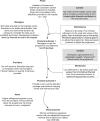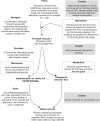Opening the 'implementation black-box' of the user fee exemption policy for caesarean section in Benin: a realist evaluation
- PMID: 31746998
- PMCID: PMC7050689
- DOI: 10.1093/heapol/czz146
Opening the 'implementation black-box' of the user fee exemption policy for caesarean section in Benin: a realist evaluation
Abstract
To improve access to maternal health services, Benin introduced in 2009 a user fee exemption policy for caesarean sections. Similar to other low- and middle-income countries, its implementation showed mixed results. Our study aimed at understanding why and in which circumstances the implementation of this policy in hospitals succeeded or failed. We adopted the realist evaluation approach and tested the initial programme theory through a multiple embedded case study design. We selected two hospitals with contrastive outcomes. We used data from 52 semi-structured interviews, a patient exit survey, a costing study of caesarean section and an analysis of financial flows. In the analysis, we used the intervention-context-actor-mechanism-outcome configuration heuristic. We identified two main causal pathways. First, in the state-owned hospital, which has a public-oriented but administrative management system, and where citizens demand accountability through various channels, the implementation process was effective. In the non-state-owned hospital, managers were guided by organizational financial interests more than by the inherent social value of the policy, there was a perceived lack of enforcement and the implementation was poor. We found that trust, perceived coercion, adherence to policy goals, perceived financial incentives and fairness in their allocation drive compliance, persuasion, positive responses to incentives and self-efficacy at the operational level to generate the policy implementation outcomes. Compliance with the policy depended on enforcement by hierarchical authority and bottom-up pressure. Persuasion depended on the alignment of the policy with personal and organizational values. Incentives may determine the adoption if they influence the local stakeholder's revenue are trustworthy and perceived as fairly allocated. Failure to anticipate the differential responses of implementers will prevent the proper implementation of user fee exemption policies and similar universal health coverage reforms.
Keywords: Public/private; evaluation; exemption mechanisms; health policy; hospitals; policy implementation; theory; user fees.
© The Author(s) 2019. Published by Oxford University Press in association with The London School of Hygiene and Tropical Medicine.
Figures
Similar articles
-
Applying the Realist Evaluation Approach to the Complex Process of Policy Implementation-The Case of the User Fee Exemption Policy for Cesarean Section in Benin.Front Public Health. 2021 Jun 8;9:553980. doi: 10.3389/fpubh.2021.553980. eCollection 2021. Front Public Health. 2021. PMID: 34169051 Free PMC article.
-
Cost and impact of policies to remove and reduce fees for obstetric care in Benin, Burkina Faso, Mali and Morocco.Int J Equity Health. 2016 Aug 2;15(1):123. doi: 10.1186/s12939-016-0412-y. Int J Equity Health. 2016. PMID: 27483993 Free PMC article.
-
Do free caesarean section policies increase inequalities in Benin and Mali?Int J Equity Health. 2018 Jun 5;17(1):71. doi: 10.1186/s12939-018-0789-x. Int J Equity Health. 2018. PMID: 29871645 Free PMC article.
-
To retain or remove user fees?: reflections on the current debate in low- and middle-income countries.Appl Health Econ Health Policy. 2006;5(3):137-53. doi: 10.2165/00148365-200605030-00001. Appl Health Econ Health Policy. 2006. PMID: 17132029 Review.
-
A systematic review of the effect of performance-based financing interventions on out-of-pocket expenses to improve access to, and the utilization of, maternal health services across health sectors in sub-Saharan Africa.J Glob Health. 2023 May 5;13:04035. doi: 10.7189/jogh.13.04035. J Glob Health. 2023. PMID: 37143430 Free PMC article.
Cited by
-
Integrated delivery of family planning and childhood immunisation services in routine outreach clinics: findings from a realist evaluation in Malawi.BMC Health Serv Res. 2020 Aug 24;20(1):777. doi: 10.1186/s12913-020-05571-1. BMC Health Serv Res. 2020. PMID: 32838774 Free PMC article.
-
Context-acceptability theories: example of family planning interventions in five African countries.Implement Sci. 2021 Jan 12;16(1):12. doi: 10.1186/s13012-020-01074-z. Implement Sci. 2021. PMID: 33435959 Free PMC article.
-
Stakeholder perceptions and experiences from the implementation of the Gratuité user fee exemption policy in Burkina Faso: a qualitative study.Health Res Policy Syst. 2023 Jun 6;21(1):46. doi: 10.1186/s12961-023-01008-3. Health Res Policy Syst. 2023. PMID: 37280694 Free PMC article.
-
A guide to systems-level, participatory, theory-informed implementation research in global health.BMJ Glob Health. 2021 Dec;6(12):e005365. doi: 10.1136/bmjgh-2021-005365. BMJ Glob Health. 2021. PMID: 34969685 Free PMC article.
-
Applying the Realist Evaluation Approach to the Complex Process of Policy Implementation-The Case of the User Fee Exemption Policy for Cesarean Section in Benin.Front Public Health. 2021 Jun 8;9:553980. doi: 10.3389/fpubh.2021.553980. eCollection 2021. Front Public Health. 2021. PMID: 34169051 Free PMC article.
References
-
- Adams A, Sedalia S, McNab S. et al. 2016. Lessons learned in using realist evaluation to assess maternal and new-born health programming in rural Bangladesh. Health Policy and Planning 31: 267–75. - PubMed
-
- Agyepong IA, Nagai RA.. 2011. We charge them; otherwise we cannot run the hospital’ front line workers, clients and health financing policy implementation gaps in Ghana. Health Policy 99: 226–33. - PubMed
-
- Ajzen I, Fishbein M.. 1980. Understanding Attitudes and Predicting Social Behavior. Pbk. Englewood Cliffs, NJ: Prentice-Hall.
-
- Bamberger M, Vaessen J, Raimondo E. (2016) Dealing with Complexity in Development Evaluation: A Practical Guide. Thousand Oaks, CA: Sage Publications, Inc.
MeSH terms
LinkOut - more resources
Full Text Sources
Medical





